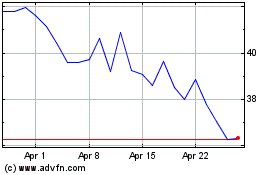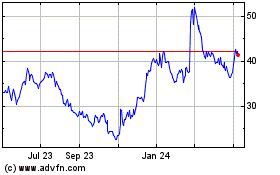Celldex Therapeutics, Inc. (NASDAQ:CLDX) today announced that the
Company has initiated a Phase 2 study of barzolvolimab in atopic
dermatitis (AD) and that the study is actively enrolling patients.
AD is one of the most common chronic inflammatory skin diseases,
with a lifetime prevalence of up to 20% of the US population and a
substantial impact on quality of life1. Mast cells are strongly
implicated in all facets of AD pathophysiology and the fundamental
processes that characterize AD, including epithelial barrier
dysfunction, immune cell recruitment, neuroinflammation2 and
multiple other mast cell-associated factors that correlate with
disease severity. Activated mast cells are also found in increased
numbers in lesional biopsies. Barzolvolimab is a humanized
monoclonal antibody that specifically binds and blocks the receptor
tyrosine kinase KIT with high specificity and potently inhibits its
activity, which is required for the function and survival of the
mast cell.
“Two-thirds of patients treated with first line systemic therapy
do not achieve complete control of their atopic dermatitis3 and
desperately need new therapies that offer rapid, meaningful relief
from the severe itching and breakdown of the skin associated with
AD,” said Diane C. Young, M.D, Senior Vice President and Chief
Medical Officer of Celldex Therapeutics. “We believe mast
cells play a critical role in the pathophysiology of AD and
utilizing our mast cell depleting agent, barzolvolimab, could yield
meaningful benefit for patients by helping them resolve their
disease and reclaim their quality of life. We’re pleased to end
this year with the advancement of barzolvolimab into its fifth
indication and look forward to an exciting year ahead in 2025 with
multiple upcoming data readouts.”
The randomized, double-blind, placebo-controlled Phase 2 study
is evaluating the efficacy and safety profile of subcutaneous
barzolvolimab in patients with moderate to severe atopic
dermatitis. Approximately 120 patients will be randomly assigned on
a 1:1:1 ratio to receive subcutaneous injections of barzolvolimab
at either 150 or 300 mg or placebo every 4 weeks after an initial
loading dose of 450 mg or placebo during a 16-week
placebo-controlled treatment phase. Participants randomized into
the placebo arm will be re-randomized at Week 16 into 1 of the 2
active treatment arms. Patients then enter a 16-week active
treatment phase, in which all patients will receive barzolvolimab
every 4 weeks. The primary endpoint of the study is to evaluate the
clinical efficacy of the two dose levels compared to placebo using
the Peak Pruritus Numerical Rating Scale (PP-NRS) at Week 16, a
well‐defined, reliable, sensitive and valid scale
for evaluating worst itch intensity in adults with
moderate‐to‐severe AD. Secondary endpoints include the evaluation
of the clinical efficacy of barzolvolimab, compared to placebo
across multiple patient-reported outcomes, including assessing
impressions of disease change and severity and improvements in
quality of life. When all clinical trial sites are open, the study
will include up to 50 clinical trial centers in the United
States.
AD is one the most common chronic, relapsing, inflammatory skin
diseases, impacting up to 20% of the US population (lifetime
prevalence). AD clinically manifests as red papules or vesicles
that are very pruritic in the acute phase and can evolve to a more
lichenified appearance in the chronic phase as a consequence of
tissue remodeling and dermal fibrosis due to inflammation and
scratching of the skin4. Up to 50% of adult AD patients have
moderate to severe disease5 and approximately 86% experience
pruritus every day, with 61% of these patients having severe or
unbearable pruritus6. The disease is generally associated with
other atopic diseases such as asthma, rhinitis, conjunctivitis, and
food allergy, where mast cells have also been shown to play a
role7. Given the unmet need in AD and barzolvolimab’s potential as
a mast cell depleting agent, Celldex believes AD is an important
indication for study.
For additional information on this trial (NCT06727552), please
visit www.clinicaltrials.gov.
1. Kawakami, et al. 2009; 2. Keith, et al. 2023; 3. Simpson,
Bieber, Guttman-Yassky, et al. 2016; 4. Bieber 2022; 5. Zhang, et
al. 2021; 6. Simpson, Bieber, Eckert, et al. 2016; 7. Fania, et al.
2022
About BarzolvolimabBarzolvolimab is a humanized
monoclonal antibody that binds the receptor tyrosine kinase KIT
with high specificity and potently inhibits its activity. KIT is
expressed in a variety of cells, including mast cells, which
mediate inflammatory responses such as hypersensitivity and
allergic reactions. KIT signaling controls the differentiation,
tissue recruitment, survival and activity of mast cells. In certain
inflammatory diseases, such as chronic urticaria, mast cell
activation plays a central role in the onset and progression of the
disease. Barzolvolimab is currently being studied in chronic
spontaneous urticaria (CSU), chronic inducible urticaria (CIndU),
prurigo nodularis (PN), eosinophilic esophagitis (EOE) and atopic
dermatitis (AD), with additional indications planned for the
future.
About Celldex Therapeutics, Inc.Celldex is a
clinical stage biotechnology company leading the science at the
intersection of mast cell biology and the development of
transformative therapeutics for patients. Our pipeline includes
antibody-based therapeutics which have the ability to engage the
human immune system and/or directly affect critical pathways to
improve the lives of patients with severe inflammatory, allergic,
autoimmune and other devastating diseases. Visit
www.celldex.com.
Forward Looking StatementThis release contains
"forward-looking statements" made pursuant to the safe harbor
provisions of the Private Securities Litigation Reform Act of 1995.
These statements are typically preceded by words such as
"believes," "expects," "anticipates," "intends," "will," "may,"
"should," or similar expressions. These forward-looking statements
reflect management's current knowledge, assumptions, judgment and
expectations regarding future performance or events. Although
management believes that the expectations reflected in such
statements are reasonable, they give no assurance that such
expectations will prove to be correct or that those goals will be
achieved, and you should be aware that actual results could differ
materially from those contained in the forward-looking statements.
Forward-looking statements are subject to a number of risks and
uncertainties, including, but not limited to, our ability to
successfully complete research and further development and
commercialization of Company drug candidates, including
barzolvolimab (also referred to as CDX-0159), in current or future
indications; the uncertainties inherent in clinical testing and
accruing patients for clinical trials; our limited experience in
bringing programs through Phase 3 clinical trials; our ability to
manage and successfully complete multiple clinical trials and the
research and development efforts for our multiple products at
varying stages of development; the availability, cost, delivery and
quality of clinical materials produced by our own manufacturing
facility or supplied by contract manufacturers, who may be our sole
source of supply; the timing, cost and uncertainty of obtaining
regulatory approvals; the failure of the market for the Company's
programs to continue to develop; our ability to protect the
Company's intellectual property; the loss of any executive officers
or key personnel or consultants; competition; changes in the
regulatory landscape or the imposition of regulations that affect
the Company's products; our ability to continue to obtain capital
to meet our long-term liquidity needs on acceptable terms, or at
all, including the additional capital which will be necessary to
complete the clinical trials that we have initiated or plan to
initiate; and other factors listed under "Risk Factors" in our
annual report on Form 10-K and quarterly reports on Form 10-Q.
All forward-looking statements are expressly qualified in their
entirety by this cautionary notice. You are cautioned not to place
undue reliance on any forward-looking statements, which speak only
as of the date of this release. We have no obligation, and
expressly disclaim any obligation, to update, revise or correct any
of the forward-looking statements, whether as a result of new
information, future events or otherwise.
Company ContactSarah CavanaughSenior Vice
President, Corporate Affairs & Administration(508)
864-8337scavanaugh@celldex.com
Patrick TillMeru Advisors(484)
788-8560ptill@meruadvisors.com
Celldex Therapeutics (NASDAQ:CLDX)
Historical Stock Chart
From Feb 2025 to Mar 2025

Celldex Therapeutics (NASDAQ:CLDX)
Historical Stock Chart
From Mar 2024 to Mar 2025
